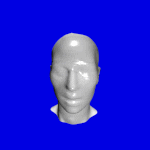|
The overwhelming part of current research into virtual source imaging relies heavily on binaural technology.
Binaural technology is based on the principle that if a sound reproduction system can generate the same sound pressures at the listener's eardrums
as would have been produced there by a real sound source, then the listener should not be able to tell the difference between the virtual image and
the real sound source. In order to know these binaural signals, or "target" signals, it is necessary to know how the listener's torso, head, and pinnae
(outer ears) modify incoming sound waves as a function of the position of the sound source. This information can be obtained by making measurements
on "dummy-heads" or human subjects. The results of such measurements are usually called head-related transfer functions, or HRTFs.
 In practice, HRTFs vary enormously between listeners, particularly at high frequencies.
The large statistical variation in HRTFs between listeners is one of the main problems with virtual source imaging over headphones.
Headphones offer good control over the reproduced sound. There is no "cross-talk" (the sound does not run round the head to the opposite ear),
and the acoustical environment does not modify the reproduced sound (room reflections do not interfere with the direct sound).
Unfortunately, though, when headphones are used for the reproduction, the virtual image is often perceived as being too close to the head, and sometimes even inside the head.
This phenomenon is particularly difficult to avoid when one attempts to place the virtual image directly in front of the listener.
It appears to be necessary to compensate not only for the listener's own HRTFs, but also for the response of the headphones used for the reproduction.
In addition, the whole sound stage moves with the listener's head (unless head-tracking is used, and this requires a lot of extra processing power).
Loudspeaker reproduction, on the other hand, provides natural listening conditions but makes it necessary to compensate for cross-talk and also to consider the reflections from the acoustical environment.
In practice, HRTFs vary enormously between listeners, particularly at high frequencies.
The large statistical variation in HRTFs between listeners is one of the main problems with virtual source imaging over headphones.
Headphones offer good control over the reproduced sound. There is no "cross-talk" (the sound does not run round the head to the opposite ear),
and the acoustical environment does not modify the reproduced sound (room reflections do not interfere with the direct sound).
Unfortunately, though, when headphones are used for the reproduction, the virtual image is often perceived as being too close to the head, and sometimes even inside the head.
This phenomenon is particularly difficult to avoid when one attempts to place the virtual image directly in front of the listener.
It appears to be necessary to compensate not only for the listener's own HRTFs, but also for the response of the headphones used for the reproduction.
In addition, the whole sound stage moves with the listener's head (unless head-tracking is used, and this requires a lot of extra processing power).
Loudspeaker reproduction, on the other hand, provides natural listening conditions but makes it necessary to compensate for cross-talk and also to consider the reflections from the acoustical environment.
|

